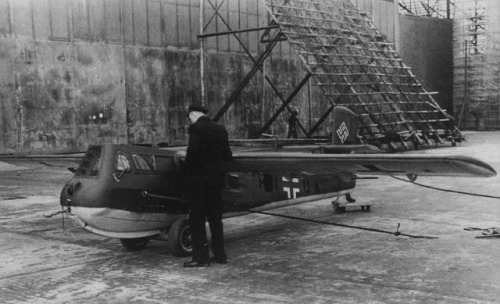peashooter85:The German World War II Glider Fighter — The BV 40By 1944 the American and Britis
peashooter85:The German World War II Glider Fighter — The BV 40By 1944 the American and British bombing campaign against Germany was really taking it’s toll. Entire cities were reduced to ruins and maintaining a war industry became much more difficult. Furthermore, throughout the war Germany suffered from shortages of vital war materials, a problem which grew worse and worse as the fortunes of war turned against the Axis Powers. The German military attempted technological solutions to the problem such as jet and rocket powered fighter interceptors. However a German company called Blohm & Voss, which was traditionally involved in shipbuilding, attempted to solve the problem with a very low tech solution.In May of 1944 Blohm & Voss successfully tested their new fighter called the BV 40. Unlike other fighter crafted of the day, the BV 40 was unique in that it was not a powered airplane, but a glider lacking an engine. The glider had to be towed into the air, with a regular BF-109 fighter plane being able tow a pair of the gliders simultaneously. The gliders would be towed above a bomber formation before being set adrift, at which point both the gliders and powered fighters would dive upon the bomber formation. To shoot down bombers, the BV 40 was equipped with a pair of MK 108 30mm cannon, which for an airplane is a very powerful gun, more than capable of downing a bomber. Each gun was loaded with 35 rounds of high explosive shells. Dimensions were a length of 18.7 feet, a wingspan of 26 feet and a height of 5.4 feet. Takeoff weight was around 2,100 lbs. It’s speed was around 345 MPH while cruising and 560 MPH in a dive.The advantages of the BV-40 was that it was cheap and easy to produce, so easy to produce that even unskilled labor (perhaps slave labor) could construct them. The air frame was produced from wood which could be sourced locally, while its skin was simple lightweight sheet metal. It was also a very small aircraft making it difficult to target and shoot down. Of course it lacked any armor, meaning if it did get hit it would most certainly be blown out of the sky. The BV-40 had very limited flight time, being able to make only one or two passes against a bomber formation before it would lose speed and be forced to land. Finally, the pilot flew the plane in a prone position, which wasn’t very comfortable.After the BV 40 was successfully tested, the German Luftwaffe ordered an initial production run of 200 gliders. However, interest in the BV 40 waned as Germany invested more in jets and rockets. The BV 40 was never adopted and only 7 prototypes were built. -- source link
Tumblr Blog : peashooter85.tumblr.com


